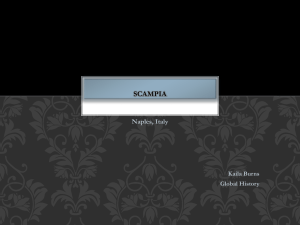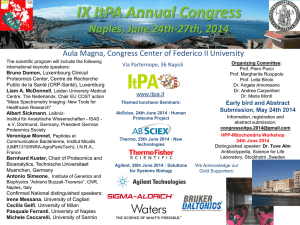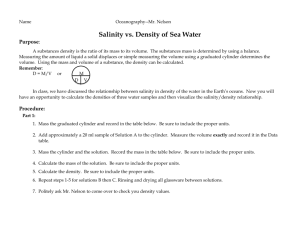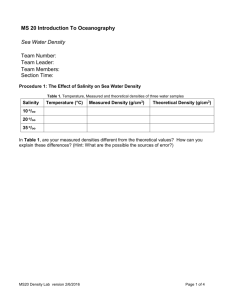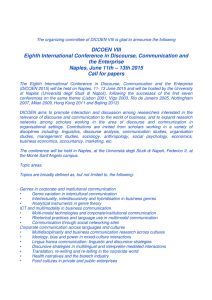hydrological flows
advertisement
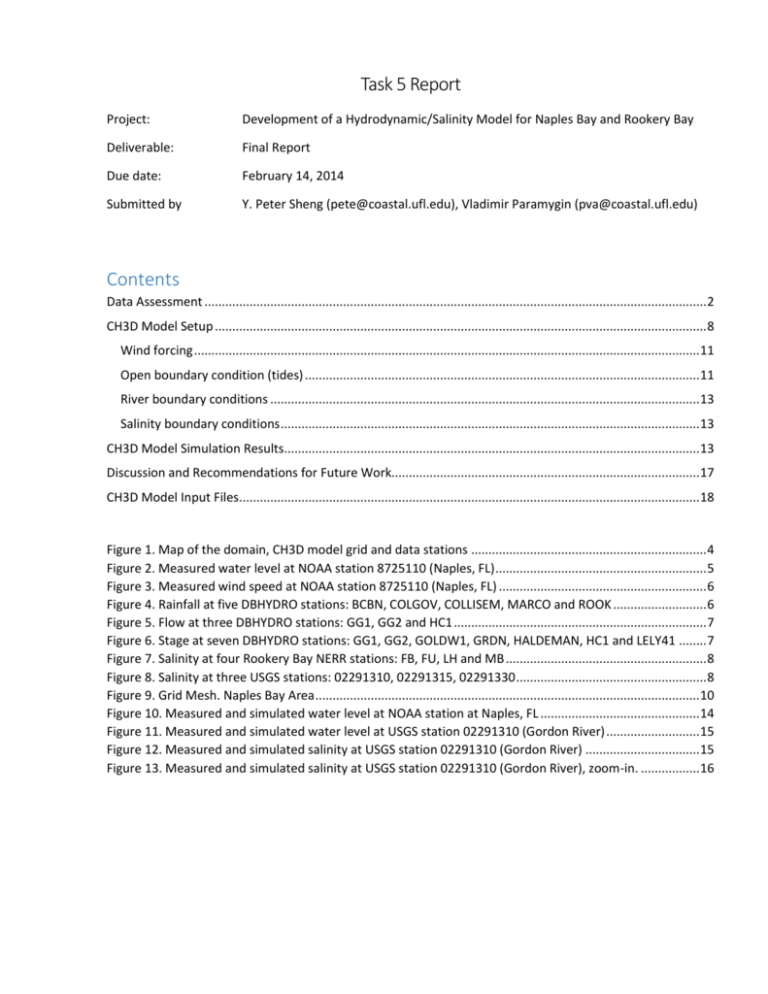
Task 5 Report Project: Development of a Hydrodynamic/Salinity Model for Naples Bay and Rookery Bay Deliverable: Final Report Due date: February 14, 2014 Submitted by Y. Peter Sheng (pete@coastal.ufl.edu), Vladimir Paramygin (pva@coastal.ufl.edu) Contents Data Assessment ................................................................................................................................................. 2 CH3D Model Setup .............................................................................................................................................. 8 Wind forcing .................................................................................................................................................. 11 Open boundary condition (tides) .................................................................................................................. 11 River boundary conditions ............................................................................................................................ 13 Salinity boundary conditions ......................................................................................................................... 13 CH3D Model Simulation Results........................................................................................................................ 13 Discussion and Recommendations for Future Work......................................................................................... 17 CH3D Model Input Files..................................................................................................................................... 18 Figure 1. Map of the domain, CH3D model grid and data stations .................................................................... 4 Figure 2. Measured water level at NOAA station 8725110 (Naples, FL) ............................................................. 5 Figure 3. Measured wind speed at NOAA station 8725110 (Naples, FL) ............................................................ 6 Figure 4. Rainfall at five DBHYDRO stations: BCBN, COLGOV, COLLISEM, MARCO and ROOK ........................... 6 Figure 5. Flow at three DBHYDRO stations: GG1, GG2 and HC1 ......................................................................... 7 Figure 6. Stage at seven DBHYDRO stations: GG1, GG2, GOLDW1, GRDN, HALDEMAN, HC1 and LELY41 ........ 7 Figure 7. Salinity at four Rookery Bay NERR stations: FB, FU, LH and MB .......................................................... 8 Figure 8. Salinity at three USGS stations: 02291310, 02291315, 02291330 ....................................................... 8 Figure 9. Grid Mesh. Naples Bay Area ............................................................................................................... 10 Figure 10. Measured and simulated water level at NOAA station at Naples, FL .............................................. 14 Figure 11. Measured and simulated water level at USGS station 02291310 (Gordon River) ........................... 15 Figure 12. Measured and simulated salinity at USGS station 02291310 (Gordon River) ................................. 15 Figure 13. Measured and simulated salinity at USGS station 02291310 (Gordon River), zoom-in. ................. 16 Data Assessment Based on a review of available data, we selected a model verification time period: January through June of 2012 (six months). Figure 1 and Table 1 show locations of data stations and types of data and some details about available data, which includes water level, flow and salinity data. Additionally, Taylor Engineering and Interflow Engineering provided 11 data points (Figure 1) and average annual flows (Table 2) at each point that can be used as boundary conditions. Since the hydrologic modeling effort is still ongoing, time varying flow data are not available at the 11 stations. Therefore, for our present project, we plan to add as many hydrological data stations (with the annual averaged flow rates) as feasible into the Naples Bay and Rookery Bay model being developed. If the hydrological modeling study is completed sufficiently early before the end of the current project, we will include the time varying hydrological data into the CH3D model. Otherwise, we can include those data in Phase II of the project. Figures 2 through 8 show the data that were collected from different sources at the stations displayed on the map in Figure 1. Table 1. Summary of data available for use in the Naples/Rookery Bay model or for model verification Station Location Name USGS 02291310 Gordon 26°08'57.9"N River at 81°47'09.98"W Rowing Club Point Near Naples, FL USGS 02291315 Naples Bay 26°07'57.96"N at City Dock 81°47'34.19"W Near Naples, FL USGS 02291330 Naples Bay 26°05'35.28"N at Gordon 81°47'53.31"W Pass Near Naples, FL 8725110 Naples, FL 26°7.9'N 81°48.4'W RBNERR UL Lower Henderson Creek, FL 26.02'57N 81.73'32W Data Type Frequency Start Data End Data Data Source Gage height [NAVD88], salinity, temperature 15 min Jul. 9th. 2011 Now USGS Gage height [NAVD88], salinity, temperature 15 min May. 28th. 2011 Now USGS Gage height [NAVD88], salinity, temperature 15 min May. 20th. 2011 Now USGS 6 min / hourly 6 min / hourly Dec. 21th. 1992 Jan. 1st. 1996 Now NOAA Now NOAA 15 min 2001 Now CDMO Wind Water level Water temperature, salinity, depth Station Name RBNERR UH Upper Henderson Creek RBNERR MB Middle Blackwater River RBNERR FU Faka Union Bay RBNERR FB Fakahatchee Bay Location Data Type Frequency Start Data End Data Data Source barometric pressure, wind speed and direction 15 min Jan.2004 Now CDMO 25° 56' 3.48 N Water temperature, 81° 35' 40.56 W salinity, depth 15 min Jan. 2002 Now CDMO 25° 54' 1.80 N Water temperature, 81° 30' 57.24 W salinity, depth 15 min Jan. 2002 Now CDMO 25° 53' 31.92 N Water temperature, 81° 28' 37.20 W salinity, depth 15 min Jan. 2002 Now CDMO 26°03.004'N 81°42.103'W Brkpt* Jul. 2004 Now DBHYDRO 26°10'05.017''N Water level 81°46'27.71''W Flow (daily averaged) Daily Sep. 2008 Now DBHYDRO 26°10'07.161''N Water level Brkpt* Dec. 2008 Now DBHYDRO 81°44'03.607''W GG2 26°10'06.406''N Flow (daily averaged) Daily Dec. 2008 Now DBHYDRO 81°44'05.249''W Brkpt* 1982 Now DBHYDRO 26°03'31.342''N Water Level HC1 81°41'20.295''W Flow (daily averaged) Daily May. 2001 Now DBHYDRO 26°13'31.318''N BCBN Rainfall Brkpt* 1990 Now DBHYDRO 81°48'29.304''W 26°07'47.332N'' COLGOV Rainfall Brkpt* May. 1996 Now DBHYDRO 81°45'45.301W'' 25°59'26.35''N COLLISEM Rainfall Brkpt* Jan. 1991 Now DBHYDRO 81°35'29.288''W 25°55'52.998''N MARCO Rainfall Brkpt* May. 2003 Now DBHYDRO 81°42'43.121''W 26°03'00.939''N ROOK Rainfall Brkpt* May. 2003 Now DBHYDRO 81°42'01.653''W 26°10'53.324''N Oct. NAPLE Water level Brkpt* Jan. 1991 DBHYDRO 81°46'00.301''W 1999 26°10'26.326''N GRDN Water level Brkpt* Sep. 2013 Now DBHYDRO 81°47'01.302''W 26°10'04.683''N Nov. GOLD.W1 Water level Brkpt* Oct. 1964 DBHYDRO 81°46'01.848''W 2012 26°07'26.333''N HALDEMAN Water level Brkpt* Jun. 1981 Now DBHYDRO 81°45'43.301''W 26°06'14.335''N LELY41 Water level Brkpt* Mar. 1980 Now DBHYDRO 81°44'46.3W'' Note: The term breakpoint is derived from the data reduction used to minimize the number of redundant points stored in the database. Time interval may be 5-15 minutes according to the data. GG1 Figure 1. Map of the domain, CH3D model grid and data stations Table 2. Estimated hydrological flows Flow Points Ranked by Flow Magnitude Avg. Annual Flow (cfs) 8 6 1 9 10 3 2 7 5 4 18.49 15.97 10.48 7.66 5.23 5.18 3.69 1.42 1.12 0.69 -0.5 0 0.5 Measured -1 Water level, m (NAVD88) Naples, FL (8725110) 2012-01-12 2012-03-12 Figure 2. Measured water level at NOAA station 8725110 (Naples, FL) 2012-05-11 Naples, FL (8725110) 10 5 0 Wind speed, m/s 15 WindSpeed 2012-01-12 2012-03-12 2012-05-11 Figure 3. Measured wind speed at NOAA station 8725110 (Naples, FL) 3.0 2.5 2.0 1.5 0.0 0.5 1.0 Rainfall, inches 3.5 4.0 BCBN COLGOV COLLISEM MARCO ROOK 2012-01-12 2012-03-12 2012-05-11 Figure 4. Rainfall at five DBHYDRO stations: BCBN, COLGOV, COLLISEM, MARCO and ROOK GG1 GG2 HC1 10 Flow, cfs 8 6 4 2 0 2012-01-12 2012-02-11 2012-03-12 2012-04-11 2012-05-11 2012-06-10 Figure 5. Flow at three DBHYDRO stations: GG1, GG2 and HC1 GG1 GG2 GOLDW1 GRDN HALDEMAN HC1 LELY41 Water level, ft (NGVD29) 8 6 4 2 0 2012-01-12 2012-03-12 2012-05-11 Figure 6. Stage at seven DBHYDRO stations: GG1, GG2, GOLDW1, GRDN, HALDEMAN, HC1 and LELY41 40 Salinity, ppt 35 30 25 20 FB FU LH MB 15 10 2012-01-12 2012-02-11 2012-03-12 2012-04-11 2012-05-11 2012-06-10 Figure 7. Salinity at four Rookery Bay NERR stations: FB, FU, LH and MB 40 35 Salinity, ppt 30 25 20 15 02291310 02291315 02291330 10 5 2012-01-12 2012-02-11 2012-03-12 2012-04-11 2012-05-11 2012-06-10 Figure 8. Salinity at three USGS stations: 02291310, 02291315, 02291330 CH3D Model Setup CH3D model was setup using the data previously described in the Data Assessment report. The CH3D model is driven by following forcing: tide, wind and river flows. The model is run in a 3D mode using six vertical sigma layers with Coriolis parameter calculated at the latitude in the middle of the domain: 26.0 degrees. Minimum model depth was set to 150 cm, due to the fact that the tidal amplitudes on the East Coast of Florida can exceed 1 meter and bathymetry data is relatively sparse, therefore bathymetry in some channels is not well resolved. The map of the domain and stations are shown in Figure 1 and the inshore portion of the domain is shown in Figure 9, and approximate grid resolution is shown in Table 3. Figure 9. Grid Mesh. Naples Bay Area Table 3. CH3D model grid properties Projection Average cell size (inshore) Average cell size (offshore) UTM Zone 17, NAD 1983 ~ 35 meters ~ 65 meters Wind forcing The wind forcing is based on two stations: the NOAA station #8725110 located near Naples, FL and the NERR station located at Henderson Creek (Figure 1). Open boundary condition (tides) The open boundary condition is derived through calibration. Initially, a set of harmonic constituents is obtained from NOAA (Table 4) and 10 major constituents (amplitude > 2cm) are selected, yielding the following constituents: K1, O1, P1, Q1, K2, M2, N2, S2, SA and SSA. These constituents are used to specify the open boundary conditions for the model. Adjustments are made to the constituents by running the model simulation and comparing the constituents at the Naples NOAA station to the simulated results and making necessary adjustments in the open boundary conditions to obtain good agreement at the Naples station. Calibrated tidal constituents at the CH3D model open boundaries are listed in Table 5. Table 4. Harmonic constituents at Naples, FL NOAA station. Amplitudes are in meters relative to MLLW. Highlighted constituents are used as forcing at the open boundary of the model. Source: http://tidesandcurrents.noaa.gov/harcon.html?id=8725110 Constituent # Name Amplitude Phase Speed Description 1 M2 0.286 359.2 2 S2 0.096 6.1 3 N2 0.057 348.4 28.4397295 Larger lunar constituent 4 K1 0.158 294.6 15.0410686 Lunar diurnal constituent 5 M4 0.017 193.6 57.9682084 Shallow water overtides of principal lunar constituent 6 O1 0.143 293.0 13.9430356 Lunar diurnal constituent 7 M6 0.008 50.0 86.9523127 Shallow water overtides of principal lunar constituent 8 MK3 0.009 101.8 44.0251729 Shallow water terdiurnal 9 S4 0.004 295.2 10 MN4 0.008 161.2 57.4238337 Shallow water constituent 11 NU2 0.013 359.7 28.5125831 Larger lunar evectional constituent 12 S6 0.0 0.0 13 MU2 0.009 275.3 27.9682084 Variational constituent 14 2N2 0.008 329.9 27.8953548 Lunar elliptical semidiurnal secondorder constituent 28.9841042 Principal lunar semidiurnal constituent 30.0 60.0 90.0 Principal solar semidiurnal constituent elliptic semidiurnal Shallow water overtides of principal solar constituent quarter diurnal Shallow water overtides of principal solar constituent Constituent # Name Amplitude Phase Speed Description 15 OO1 0.005 301.6 16 LAM2 0.002 2.4 17 S1 0.017 29.0 18 M1 0.008 321.5 14.4966939 Smaller lunar elliptic diurnal constituent 19 J1 0.01 289.9 15.5854433 Smaller lunar elliptic diurnal constituent 20 MM 0.0 0.0 0.5443747 Lunar monthly constituent 21 SSA 0.03 66.2 0.0821373 Solar semiannual constituent 22 SA 0.075 167.6 0.0410686 Solar annual constituent 23 MSF 0.0 0.0 1.0158958 Lunisolar synodic fortnightly constituent 24 MF 0.0 0.0 1.0980331 Lunisolar fortnightly constituent 25 RHO 0.006 292.1 13.4715145 Larger lunar constituent 26 Q1 0.03 282.4 13.3986609 Larger lunar elliptic diurnal constituent 27 T2 0.005 357.9 29.9589333 Larger solar elliptic constituent 28 R2 0.001 6.4 30.0410667 Smaller solar elliptic constituent 29 2Q1 0.004 263.3 12.8542862 Larger elliptic diurnal 30 P1 0.052 294.0 14.9589314 Solar diurnal constituent 31 2SM2 0.0 0.0 31.0158958 Shallow water semidiurnal constituent 32 M3 0.0 0.0 43.4761563 Lunar terdiurnal constituent 33 L2 0.008 39.1 29.5284789 Smaller lunar constituent 34 2MK3 0.009 86.9 42.9271398 Shallow water terdiurnal constituent 35 K2 0.027 358.9 30.0821373 Lunisolar semidiurnal constituent 36 M8 0.0 0.0 37 MS4 0.008 217.2 16.1391017 Lunar diurnal 29.4556253 Smaller lunar evectional constituent 15.0 Solar diurnal constituent evectional elliptic diurnal semidiurnal 115.9364166 Shallow water eighth diurnal constituent 58.9841042 Shallow water constituent quarter diurnal Table 5. Open boundary conditions at the open boundary of CH3D model domain. Amplitudes and phases are relative to January 1, 2012 00:00. Tidal constituent K1 O1 P1 Q1 K2 M2 N2 S2 SA SSA Amplitude 47.7 5.7 9.6 2.7 14.3 15.8 5.2 3.0 7.5 3.0 Phase -27.1 91.0 153.0 -51.1 179.8 -0.1 19.4 -40.2 171.1 226.5 River boundary conditions The river boundary conditions are based on the flows at the stations identified on the map in Figure 1: GG1, HC1, 1, 2, 3, 8, and 9. The GG1 and HC1 data are obtained from the DBHYDRO database, and other stations are based on the estimated hydrological flows provided by Taylor Engineering / SFWMD. Salinity boundary conditions The salinity at river (flow) boundaries of CH3D model is set at 0 ppt (fresh water flow) as river boundaries are sufficiently far from the inlet and there is no salt water intrusion at these points. At the open boundary of the domain (offshore) different options were explored. Based on analysis of available data, such as regional model results (HYCOM, NCOM) it was concluded that in the offshore the variation of salinity is very small (~ 0.3 ppt) over the 6 months period and is even smaller (less than 0.1 ppt) at any instance of time over the CH3D boundary in vertical and horizontal directions. Therefore, it was decided to use a single constant value at the offshore open boundary of 35.5 ppt (average value over the time period of simulation). Various model parameters not discussed here can be found in the main hydrodynamic input file for the CH3D model that accompanies this report. CH3D Model Simulation Results Using the CH3D model and the model domain shown in Figure 1, test simulation results for the first six months of 2012 are obtained. Results of water level and salinity are compared with measured data. The following stations (Table 6) are selected to evaluate the model (refer to Figure 1 for station locations). Table 6. List of stations selected for control of model results Station Name USGS 02291310 Gordon River at Rowing Club Point Near Naples, FL USGS 02291315 Naples Bay at City Dock Near Naples, FL USGS 02291330 Naples Bay at Gordon Pass Near Naples, FL 8725110 Naples, FL RBNERR LH Lower Henderson Creek, FL Location 26°08'57.9"N 81°47'09.98"W 26°07'57.96"N 81°47'34.19"W 26°05'35.28"N 81°47'53.31"W 26°7.9'N 81°48.4'W 26.02'57N 81.73'32W Data Type Water level, salinity Water level, salinity Water level, salinity Water level Salinity Frequency Data Source 15 min USGS 15 min USGS 15 min USGS 6 min 15 min NOAA CDMO Table 7 contains the statistical measures of model to data comparisons such as coefficient of determination and root mean square and Figures 10-14 show the plots of measured and simulated data. While water levels and salinity show reasonable agreement near the coast, the inland station 02291310 (Gordon River) (Error! Reference source not found.) shows some negative phase lag in water level, which hould be addressed by further model calibration and verifying the bathymetry of the river to that point. Salinity comparison at this station (Figures 13 and 14) shows considerable deviation as well, as measured data shows significant stratification between the top and bottom, but model results show little stratification and results match with data better at the top layer. It is possible that an increase in the number of layers would help to improve the results (currently 4 vertical layers are used in the model). Table 7. Coefficient of determination (r2) and root mean square error (RMSE) for measured and simulated data at select stations Station Name USGS 02291310 Gordon River at Rowing Club Point Near Naples, FL USGS 02291315 Naples Bay at City Dock Near Naples, FL USGS 02291330 Naples Bay at Gordon Pass Near Naples, FL 8725110 Naples, FL USGS 02291310 Gordon River at Rowing Club Point Near Naples, FL USGS 02291315 Naples Bay at City Dock Near Naples, FL USGS 02291330 Naples Bay at Gordon Pass Near Naples, FL Water level, m (NAVD88) 0.5 Data Type Water Level r2 0.83 RMSE 8 cm Water Level 0.87 9 cm Water Level 0.90 6 cm Water Level Salinity (bottom/top) Salinity (bottom/top) Salinity (bottom/top) 0.93 0.52 0.57 0.81 0.79 0.90 0.89 6 cm 8 ppt Naples, FL (8725110) 6 ppt 2 ppt Measured Simulated 0 -0.5 -1 2012-01-14 2012-01-28 2012-02-11 2012-02-25 2012-03-10 Figure 10. Measured and simulated water level at NOAA station at Naples, FL 2012-03-24 Figure 11. Measured and simulated water level at USGS station 02291310 (Gordon River) Measured (top) Measured (bottom) Simulated (top) Simulated (bottom) 40 35 Salinity, ppt 30 25 20 15 10 2012-01-12 2012-02-11 2012-03-12 Figure 12. Measured and simulated salinity at USGS station 02291310 (Gordon River) Measured (top) Measured (bottom) Simulated (top) Simulated (bottom) Salinity, ppt 35 30 25 20 15 2012-01-04 2012-01-08 Figure 13. Measured and simulated salinity at USGS station 02291310 (Gordon River), zoom-in. Discussion and Recommendations for Future Work The CH3D model was setup using boundary conditions and parameterizations defined above. Simulation of a 6-month period produced plausible results, with RMSE of salinity between 2 and 8 ppt, given the limitations of available data. The model domain and setup were tailored such that the model execution time are in-line with the time recommended by the sponsor and are less than one day per year of simulation (in serial mode using a PC based on Intel Core i7 CPU). The model code uses about 1.5GB of memory during runtime. If the model code is used on computers with lower single core performance but multiple CPUs or CPU cores available, parallel model could be employed to keep the model performance in line with or to exceed the recommended performance. Based on the initial model simulation and several subsequent model sensitivity runs, we believe that the following weaknesses currently exist in the model: Bathymetry data – while there is a good bathymetric dataset available for the Naples Bay, the data for the Rookery Bay is rather sparse and channels may not be represented correctly in the model, thus causing incorrect flowrates through these channels. Flowrates at river boundaries – the data provided by Taylor Engineering is limited to annually averaged flows. Improved boundary conditions could significantly improve results of salinity simulations. Tidal boundary conditions – two of the tidal constituents, SA and SSA, have periods (~12 and ~6 months, respectively) that are comparable to or longer than the period of simulation, therefore accuracy of calibration for these constituents could have significant error. A 2-4 year simulation would be desirable to calibrate and verify these constituents. CH3D Model Input Files An archive with a set of CH3D input files accompanies this report the files include: fort.4 fort.15 grid.gdep fort.1301 fort.14 fort.73 Main CH3D model input file Model grid (binary format) Model grid (ascii text format) Rivers and streams (flow boundary conditions) Wind forcing Initial conditions

